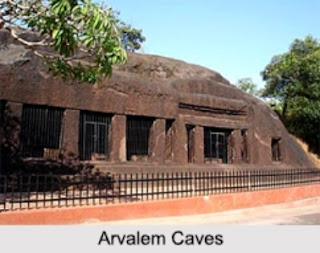Nestled in the serene hills of North Goa, the
Arvalem Caves are a captivating historical site that offers a unique glimpse
into the region's ancient past. Also known as the Arvalem Rock Cut Caves, these
ancient caves are a testament to the region's rich cultural heritage,
attracting history enthusiasts and tourists alike. Dating back to the 6th
century, the caves are believed to have been carved out of solid rock,
showcasing the remarkable craftsmanship of their creators.
The Arvalem Caves are often
associated with Buddhist influences, as evidenced by their architectural style
and design. However, some historians also suggest that they might have been
used by Hindu monks, given the presence of sculptures depicting Hindu deities.
This blend of influences highlights the syncretic culture of ancient Goa, where
different religious and cultural traditions coexisted harmoniously.
The caves consist of five rock-cut chambers, with
the most significant being a large hall that features a central lotus-shaped
platform, likely used for meditation or rituals. The intricate carvings and
engravings on the cave walls reflect the artistic prowess of the period and
provide insight into the spiritual practices of the time.
One of the standout features of the Arvalem Caves
is their impressive rock-cut architecture. The caves are hewn from laterite
rock, a material prevalent in the region, and showcase a blend of simplicity
and sophistication. The interiors are characterized by high ceilings, spacious
chambers, and intricately carved pillars. Despite the passage of centuries, the
structural integrity of the caves remains intact, allowing visitors to
appreciate the skill and ingenuity of the ancient artisans.
Visitors will notice various carvings that adorn
the walls, including motifs of lotus flowers and geometric patterns. These
designs not only enhance the aesthetic appeal of the caves but also reflect the
cultural and religious significance of the time.
The Arvalem
Caves are located near the picturesque Arvalem Waterfall, which adds to the
charm of the area. The waterfall, particularly during the monsoon season,
offers a stunning backdrop for photographs and a peaceful spot for relaxation.
The lush greenery surrounding the caves creates a tranquil atmosphere, making
it an ideal destination for nature lovers and those seeking a retreat from the
hustle and bustle of city life.
Additionally, the nearby Rudreshwar Temple,
dedicated to Lord Shiva, is worth a visit. This temple, set against the
backdrop of the caves, provides a deeper understanding of the spiritual context
of the region.
The Arvalem Caves are accessible by road, making
them a convenient stop for travelers exploring North Goa. While there is no
entry fee, visitors are encouraged to maintain the cleanliness and sanctity of
the site. The best time to visit is during the cooler months, from November to
February, when the weather is pleasant and conducive for exploration.
In conclusion, the Arvalem
Caves are more than just an archaeological site; they are a portal to the past,
inviting visitors to reflect on the region's diverse cultural heritage. Whether
you're a history buff, an architecture enthusiast, or simply looking for a
peaceful escape, a visit to the Arvalem Caves promises to be a rewarding
experience. Embrace the tranquility, soak in the history, and let the ancient
stones tell their stories.
